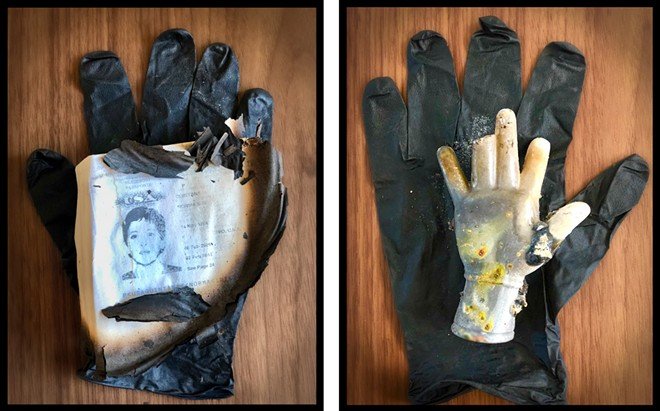“FACING FIRE” EXHIBIT AT GONZAGA’S JUNDT ART MUSUEM EXPLORES HUMANITY’S GROWING FAMILIARITY WITH WILDFIRES
BY MADISON PEARSON 01/19/2023 original articleKing Fire Self Portrait by Jeff Frost (2018) Courtesy of the artist
NORMA I. QUINTANA IS NO STRANGER TO FIRE. She and her family lost their home five years ago as wildfires ravaged Northern California.
"I remember the exact date," says Quintana, a Puerto Rican-American photographer based out of Napa, California. "Oct. 8, 2017."
Symbolically, fire can represent passion, ambition and unpredictability. But for many, like Quintana, its dancing flames mean unprecedented loss, unbridled fear or even death.
Fire is reflected in such myriad perspectives in the Jundt Art Museum's new exhibition, "Facing Fire: Art, Wildfire, and the End of Nature in the New West," on loan from the California Museum of Photography. From depicting flames as an omen to a destructive force, each of the show's 14 artists, including Quintana, reflect how fire has personally impacted their life.
The fires that began burning across California in fall 2017 became one of the deadliest wildfire events of the past century in the U.S. The natural disaster took the lives of 44 people and hospitalized about 192 others — and destroyed countless homes and buildings spread across 210,000 acres.
When Quintana and her family initially evacuated, she firmly believed she'd return to a home that was still standing strong.
"It was such a crushing feeling," she recalls. "It felt like war. Like we had come back and a missile had landed on our home."
Sharing exhibition space with Quintana, and the other artists featured in "Facing Fire," is Samantha Fields whose interest in depicting disaster started when her grandfather's house was destroyed by a tornado during childhood.
"I was haunted by that," Fields says. "Terrified. But, seeing images of them was so fascinating to me."
After a chance encounter with a wildfire while on a road trip, Fields added fires to her list of fascinations.
At first glance, Fields' pieces in the exhibition appear to be stunning photographs of wildfires. Move in a bit closer and it becomes apparent that her canvases are stacked with layer upon layer of airbrushed acrylic paint. So smooth, it's hard to differentiate her work from the photography presented in the exhibition.
Each of the 48 painted canvases, arranged in a grid formation, features a depiction of a different wildfire that Fields has captured over the past 15 years.
"Fire is such a normal part of our lives now," Fields says. "I've lived long enough to see it get worse. Raising awareness about climate change is why I choose to depict these ideas of survival and destruction."
Quintana's canvases are also presented in a grid, but the ways in which the artists have chosen to express their interactions with fire are vastly different. Fields' work shows the devastation of burning hillsides in progress while Quintana's shows the devastation that comes after the flames and out of the ashes.
"I didn't want to take photos of the burned site of my home," Quintana recalls. "I never wanted to do that. I wanted to capture an image that spoke to the memory of the event."
Once the smoke cleared, Quintana's documentarian instincts kicked in. The Atlas Peak fire that took her home also incinerated her photography studio and all of the cameras within it. All she had left was her cell phone.
"The first responders gave us gloves and sieves," she says. "We started going through our scorched belongings."
After literally sifting through the contents of her house, Quintana collected the recovered remnants of her life and did what she has always done: captured memories.
Being a film-only photographer, she deviated from her norm in order to create the digital photos displayed in "Facing Fire."
Quintana took the salvaged items, placed them on top of a used, ashen glove, and began taking top-down photos with her iPhone.
Each photo of Quintana's is framed the same way, but the objects featured range from the husks of camera bodies once used to capture circus performers, remnants of jewelry that hung around the photographer's neck, and even the charred pages of Quintana's passport. She describes the process as birthing past memories, like an archaeologist on an excavation site far, far away.
Quintana and her family were displaced for three months while they picked up the pieces of what remained, dealt with the loss and processed the trauma of the events that had occurred.
"After the fire, people would tell me 'Well, at least you have your life,'" Quintana recalls. "But these objects once collectively made up what I called home. Fire took that from me."
"Facing Fire: Art, Wildfire, and the End of Nature in the New West" • Jan. 21-May 13, open Mon-Sat from 10 am-4 pm • Free • Jundt Art Museum • 200 E. Desmet Ave. • gonzaga.edu/jundt


